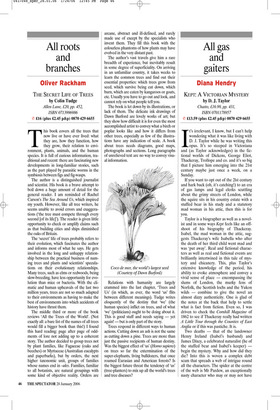All roots and branches
Oliver Rackham
THE SECRET LIFE OF TREES by Colin Tudge Allen Lane, £20, pp. 452, ISBN 0713996986 ✆ £16 (plus £2.45 p&p) 0870 429 6655 This book covers all the trees that now live or have ever lived: what they are, how they function, how they grow, their relation to environment, plants, animals, and the human species. It is full of curious information, traditional and recent: there are fascinating new developments in long-familiar stories, such as the part played by parasitic worms in the symbiosis between figs and fig-wasps.
The author is a distinguished journalist and scientist. His book is a brave attempt to boil down a huge amount of detail for the general reader. I am reminded of Rachel Carson’s The Sea Around Us, which inspired my youth. However, like all tree writers, he seems unable to avoid errors and exaggerations (‘the tree must compete through every second [of its life]’). The reader is given little opportunity to check or amplify claims such as that building cities and ships diminished the oaks of Britain.
The ‘secret’ life of trees probably refers to their evolution, which fascinates the author and informs most of what he says. He gets involved in the long and unhappy relationship between the practical business of naming trees and plants and scientists’ speculations on their evolutionary relationships. Many trees, such as elms or redwoods, being slow-breeding, have less opportunity for evolution than mice or bacteria. With the climatic and human upheavals of the last two million years, trees are not so much adapted to their environments as having to make the best of environments into which accidents of history have thrust them.
The middle third or more of the book reviews ‘All the Trees of the World’. (Not exactly all: a bare list of the names of all trees would fill a bigger book than this!) I found this hard reading: page after page of oddments of lore not adding up to a coherent story. The author decided to group trees not by plant families, like Fagaceae (oaks and beeches) or Myrtaceae (Australian eucalypts and paperbarks), but by orders, the next higher taxonomic unit, groups of families whose names end in –ales. Families, familiar to all botanists, are natural groupings with some kind of objective reality. Orders are arcane, abstract and ill-defined, and rarely made use of except by the specialists who invent them. They fill this book with the colourless phantoms of how plants may have evolved in the very distant past.
The author’s vast travels give him a rare breadth of experience, but inevitably result in some degree of superficiality. On arriving in an unfamiliar country, it takes weeks to learn the common trees and find out their essential properties: which trees grow from seed, which survive being cut down, which burn, which are eaten by kangaroos or goats, etc. Usually you have to go out and look, and cannot rely on what people tell you.
The book is let down by its illustrations, or lack of them. The delicate ink drawings of Dawn Burford are lovely works of art; but they show how difficult it is for even the most accomplished artist to convey what a birch or poplar looks like and how it differs from other trees, especially as few of the illustrations have any indication of scale. A book about trees needs diagrams, good maps, photographs and sections. Long paragraphs of unrelieved text are no way to convey visual information.
Relations with humanity are largely crammed into the last chapter, ‘Trees and Us’ (in which, as ever, the word ‘us’ flits between different meanings). Tudge writes eloquently of the destiny that ‘we’ (the human species) inflict on trees, and of what ‘we’ (politicians) ought to be doing about it. This is good stuff and needs saying — yet again! — but is only part of the story.
Trees respond in different ways to human actions. Cutting down an ash is not the same as cutting down a pine. Trees are more than just the passive recipients of human destiny. Was the biggest effect of ‘us’ (Homo sapiens) on trees so far the extermination of the super-elephants, living bulldozers, that once roamed Eurasian and American forests? Is the biggest future threat the tendency of ‘us’ (tree-planters) to mix up all the world’s trees and tree diseases?






















































 Previous page
Previous page